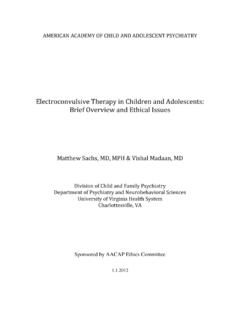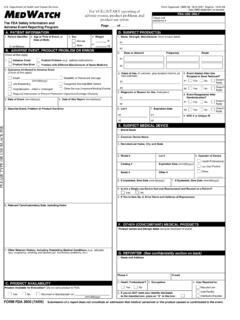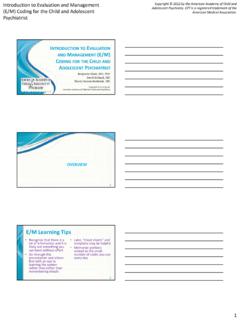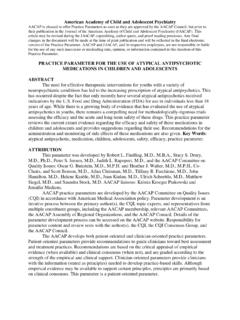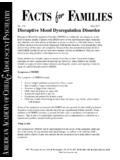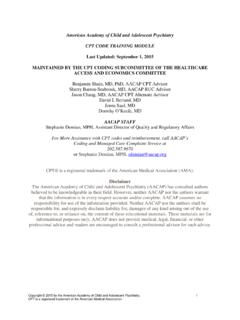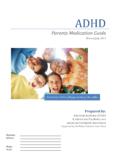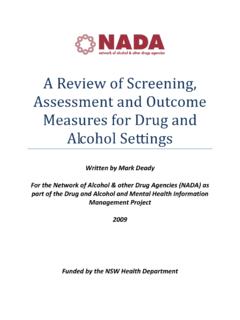Transcription of CASII - American Academy of Child and Adolescent …
1 CASII Child and Adolescent Service Intensity Instrument Background information and Initial Data Analysis American Academy of Child and Adolescent Psychiatry AACAP Work Group on Community Systems of Care for Seriously Emotionally Disturbed children Principal Investigator - Theodore Fallon, Jr., MD, MPH CoPrincipal Investigator - Andres Pumariega, MD Work Group members: Mark Chenven, , Emilio Dominguez, , Katherine Grimes, , Graeme Hanson, , William Heffron, , Robert Klaehn, , Larry Marx, , Tom Vaughan, Jr., , Nancy Winters, , and Al Zachik, AACAP Staff: Kristin Kroeger Ptakowski, Director of Clinical Affairs June 2001 2 INTRODUCTION When a Child or Adolescent presents for mental health care, either in the private or public sector, whether it be in the medical, mental health, juvenile justice, or Child protective system, there has been no standardized way to link the presentation of the Child with a level of service that the Child / Adolescent needs.
2 This has been true despite the fact that managed care, class action suits and consent decrees, such as Willy M. (in North Carolina), have all been predicated on such an established link. In addition, the concepts of wraparound and serious emotional disturbance require a link between presentation and level of service if these concepts are to move forward and be more generally accepted by the public. These facts beg for a standard that can provide a link between the presentation of a Child or Adolescent and a recommendation for level of service. The American Academy of Child and Adolescent Psychiatry has an opportunity to take the lead in providing this public standard, which up to now has not existed. There have been a number of previous attempts to use clinical assessments as a method of determining the appropriate level of care for children and adolescents. There has, however, never been a clearly defined method available in the public domain for linking the results of a clinical assessment to a level of care best suited for treatment.
3 Traditional psychiatric assessment instruments such at the Diagnostic interview schedule for children (DISC) or the Child Behavior Checklist (CBCL) provide information on clinical status with regard to mood, anxiety, behavior or thought process, but they did not have a connection with treatment needs. These instruments fail to take into account the interaction that the Child or Adolescent has with his/her environment. Other instruments such as the Child and Adolescent Functional Assessment Scale (CAFAS), like the CBCL, uses a dimensional approach to assess the Child or Adolescent s interaction with the environment, but fail to take into account the environment itself, which creates stresses for and supports the Child or Adolescent . There are proprietary instruments such as the Level of Care Assessment Tool (LOCAT) used by USHealthCare that do take into account aspects of the environment, but these have not been normed and have not been available for public reference or use.
4 Another approach to patient treatment and placement has focused on criteria specific to a particular program. For example, a day hospital might have a set of criteria that would describe the type of patient deemed most appropriate for that program. This idea has evolved into the concept of level of care, which attempted to group services of similar intensity together. But again, there is no overall structure that links patient needs with intensity of service. 3 INSTRUMENT DEVELOPMENT With these challenges in mind, the AACAP s Work Group on Community Systems of Care, in collaboration with the American Association of Community Psychiatrists, developed the Child and Adolescent Service Intensity Instrument, formerly called the Child and Adolescent Level of Care Utilization System (CALOCUS). The CASII instrument is a tool to determine the appropriate level of care placement for a Child or Adolescent . It was designed to facilitate communication between personnel involved on both sides of the equation, clinical need as well as resource availability, and to create a standard context in which all participants are working together.
5 The CASII takes into consideration Child development and the importance of the parents and the community in supporting the Child . It takes into consideration developmental disorders such as mental retardation, autism and delinquency, and to consider the contributions of the Child / Adolescent as well at the parent and family. This scale also draws from clinical experience, and considers a number of values, theories, and resources. Levels of care are clearly defined within interagency systems of care philosophy using a wraparound process, where services are Child -centered, family focused and driven, culturally competent and individualized to the Child s multiple needs and context. This instrument draws from clinical experience and a number of values, theories, and resources, including: CASSP /Guiding Principles for Systems of Care (Stroul and Friedman, 1986), which advocates for community-and family-centered treatment in the least restrictive, most normative clinically appropriate environment; Developmental theory, which describes the trajectory of normative physical, emotional, cognitive, and social changes of childhood and adolescents, which must be addressed in both assessment and treatment; Family empowerment, in which the family is respected and regarded as the lead agent in assessment, treatment, and case management activities for the Child or Adolescent and is viewed as the primary agent for fostering healthy development and growth in the Child or Adolescent ; Cultural competence (Cross, Bazrow, Dennis, and Issacs, 1998.)
6 Pumariega and Cross, 1997), which embodies respect for people of all ethnic backgrounds, accommodation of their special needs ( culturally appropriate assessment and treatment, linguistic support) and whenever possible, provision of services by culturally competent professionals and staff members whose ethnic diversity mirrors that of the populations served. Cultural factors often impact the assessment of co-morbidity, level of functioning, environmental support, and treatment and engagement, thus directly biasing the level of care placement. 4 Wraparound concepts, which entail the integration of a comprehensive network of professional and support services for the Child or Adolescent and family using naturally existing community supports; as well as inter-organizational structures capable of providing blended funding streams to provide service (VanDenBerg and Grealish, 1996). This model supports the use of a strength-based, individualized service plan (ISP) for each Child and Adolescent .
7 Clinical expertise provided by two international organizations comprised of psychiatrists serving children and adolescents, and adults with a variety or psychiatric, substance use, and developmental disorders ( American Academy of Child and Adolescent Psychiatry and American Association of community Psychiatrists). The CASII links a clinical assessment with standardized levels of care and has a method for matching the two. The method consists of quantifying the clinical severity and service needs on six dimensions (eight ratings) that are standardized using anchor points. The ratings are quantified in order to convey information easily, but also provide a spectrum along which a Child / Adolescent may lie on any given dimension. This allows for a broad range of users to employ the CASII . This can be done for any Child / Adolescent in any setting regardless of diagnosis or the system the Child is involved with. The instrument also considers three distinct types of disorder: psychiatric disorders, substance use disorders, or developmental disorders (including autism and mental retardation), and has the ability to integrate these as overlapping clinical issues.
8 Once the dimensional ratings are done, the scores are combined to generate a level of care recommendation. This integration of multiple dimensions is the essence of the CASII instrument. It is this that guides the user to an appropriate CASII level of care assignment. In order to develop an instrument applicable to a wide variety of treatment environments (including rural areas where established mental health services are rare) and Child or Adolescent needs, it was important to develop a set of definitions for levels of care that described the resource intensities needed at each specific level of care. These definitions needed to be flexible and adaptable, in order to be broadly applicable to the wide variety of treatment environments in which care can be given. This approach was chosen to allow for service providers to give adequate clinical services and quality care in the most economic and realistic fashion. How user friendly the instrument was also important.
9 It was anticipated that ease of use, time, and universal adaptability would be critical factors in establishing broad acceptability of CASII . This instrument is anticipated to lead to the establishment of a single Child and Adolescent standard for use by insurance and governmental agencies, service providers and consumers. CASII employs multi-disciplinary/multi-informant perspectives on children and adolescents and is designed to be used by a variety of mental health professionals. Although it is primarily used for initial level of care placement decisions, it can be used at all stages of treatment to assess the level of intensity of services needed. An important aspect of CASII is its potential use for fee-for-service utilization management. Many instruments in the past have developed separate 5criteria for hospital admissions, continuing care and discharge planning. The CASII instrument makes it unnecessary to use different criteria because of the dynamic nature of the quantifiable dimensional ratings.
10 CASII can also be applied to activities such as treatment planning, outcome monitoring and program development. There are a number of things that CASII will not do. It will not prescribe program design, but rather, it recommends the type and intensity of resources that need to be available in that program. It does not specify treatment intervention, and it does not invalidate the importance of clinical judgement. The CASII also does not limit creativity in developing specific treatment programs that meet the needs of special populations or localities. INSTRUMENT STRUCTURE DIMENSIONAL RATING SYSTEM The CASII dimensional rating system is used to determine the intensity of needed services. It operationalizes the factors clinicians consider in determining the most appropriate services and level of care needed. CASII has six dimensions: RISK OF HARM: This dimension is the measurement of a Child or Adolescent 's risk of harm to self or other as well as an assessment of his/her potential for being a victim of physical or sexual abuse, or neglect.
